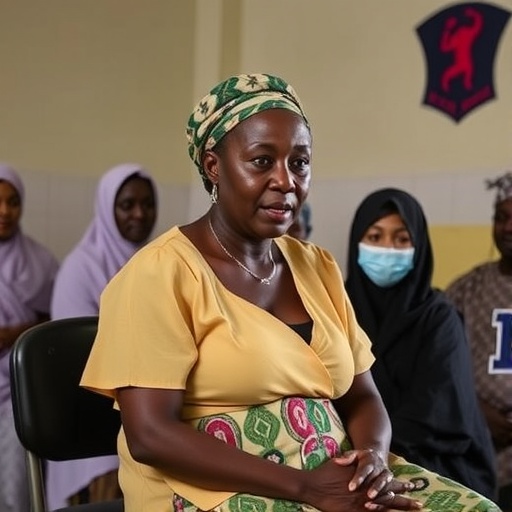Cervical Cancer Screening Reaches Nigerian Brothels – Bioengineer.org

Report on Cervical Cancer Screening Among Female Sex Workers in North-Western Nigeria
Introduction: Aligning with Sustainable Development Goals
A pivotal study conducted in Sokoto State, North-Western Nigeria, has investigated the prevalence of high-risk human papillomavirus (HPV) and cervical cytological abnormalities among female sex workers (FSWs). This research directly addresses critical gaps in public health delivery and aligns with several United Nations Sustainable Development Goals (SDGs), particularly SDG 3 (Good Health and Well-being), SDG 5 (Gender Equality), and SDG 10 (Reduced Inequalities). By focusing on a marginalized and vulnerable population, the study pioneers a model for equitable healthcare access, a core tenet of the 2030 Agenda for Sustainable Development.
Methodology: An Inclusive Approach to Health Equity
The study employed a cross-sectional design, recruiting 165 FSWs through innovative outreach well-woman clinics established directly within brothels. This “doorstep” delivery model is a significant step towards achieving SDG 10 by dismantling structural and social barriers to healthcare for marginalized communities.
Data Collection and Analysis
- Recruitment: Participants were recruited from outreach clinics in brothel settings.
- Data Instruments: Structured questionnaires were used to collect socio-demographic and risk factor data.
- Diagnostic Procedures: Cervical smears were collected and analyzed using advanced technologies, including liquid-based cytology (LBC) and real-time polymerase chain reaction (PCR) assays for HPV DNA detection. This application of modern diagnostics in a low-resource setting supports SDG 9 (Industry, Innovation, and Infrastructure).
Key Findings and Public Health Implications
The research yielded critical data on the health status of FSWs in the region, highlighting an urgent need for targeted public health interventions.
Prevalence and Risk Factors
- Screening Acceptance: Nearly 73% of the cohort consented to screening, demonstrating the high acceptability and feasibility of the outreach model.
- HPV Infection Rates: Over 50% of screened participants tested positive for high-risk HPV types 16 and 18, the primary oncogenic strains responsible for cervical cancer.
- Cytological Abnormalities: Just over 8% of participants presented with cervical cytological abnormalities, predominantly low-grade squamous intraepithelial lesions (LSIL), indicating an important window for early intervention.
- Significant Predictor: Multivariate analysis identified the number of years engaged in sex work as the sole significant predictor of HPV 16/18 infection, with women in the profession longer having over five times the odds of infection.
Contributions to the Sustainable Development Agenda
The study’s outcomes and proposed interventions provide a clear framework for advancing multiple SDGs.
SDG 3: Good Health and Well-being
The findings underscore the necessity of targeted health programs to meet Target 3.4 (reduce premature mortality from non-communicable diseases). Recommendations include:
- Implementing and scaling bivalent HPV vaccination programs for FSWs.
- Establishing regular cervical cancer screening and follow-up services to prevent progression to invasive cancer.
- Integrating these services into existing sexual health programs to ensure comprehensive care.
SDG 5: Gender Equality and Empowerment
By focusing on the health needs of FSWs, the study promotes Target 5.1 (end discrimination against all women) and Target 5.6 (ensure universal access to sexual and reproductive health). The outreach model empowers a highly stigmatized group of women by providing respectful, accessible, and life-saving health services, reinforcing health as a fundamental human right.
SDG 10: Reduced Inequalities
The research is a prime example of action towards Target 10.2 (promote universal social, economic, and political inclusion) and Target 10.3 (ensure equal opportunity and reduce inequalities of outcome). The “taking it to their doorstep” approach directly confronts the health disparities faced by FSWs due to socioeconomic marginalization and stigma.
Recommendations for Policy and Practice
Based on the study’s findings, the following actions are recommended to build a sustainable and equitable public health response:
- Policy Integration: Government and public health agencies should formally integrate HPV vaccination and cervical cancer screening into all sexual health programs targeting FSWs.
- Partnership and Collaboration: In line with SDG 17 (Partnerships for the Goals), forge strong collaborations between government bodies, non-governmental organizations (NGOs), and community stakeholders to ensure the sustainability of outreach programs.
- Further Research: Conduct larger-scale studies with comprehensive genotyping of all high-risk HPV strains to inform and refine regional vaccination and screening strategies.
- Replication of Model: The successful outreach clinic model should be documented and replicated in other regions and for other marginalized populations to advance health equity on a broader scale.
Conclusion
This research from North-Western Nigeria provides more than critical epidemiological data; it offers a replicable, community-engaged model for healthcare delivery that champions health equity. By successfully bringing advanced cervical cancer screening to a vulnerable population, the study provides a clear and actionable path toward reducing the burden of cervical cancer and achieving key targets within the Sustainable Development Goals. It serves as a call to action for global health stakeholders to invest in targeted, inclusive, and empowering interventions that leave no one behind.
Analysis of Sustainable Development Goals in the Article
1. Which SDGs are addressed or connected to the issues highlighted in the article?
SDG 3: Good Health and Well-being
- The article’s central theme is public health, specifically focusing on preventing a leading cause of cancer-related mortality among women. It details a “groundbreaking study” on “cervical cancer among female sex workers (FSWs)”, directly aligning with the goal of ensuring healthy lives and promoting well-being. The entire initiative of providing “outreach well-woman clinics” is a direct effort to improve health outcomes for a vulnerable group.
SDG 5: Gender Equality
- The study focuses on a health issue, cervical cancer, that exclusively affects women. It further concentrates on FSWs, a marginalized group of women who are often victims of stigma and policy neglect. By advocating for their health and bringing “lifesaving services” to them, the article addresses the need to empower women and ensure their access to healthcare, which is a critical component of gender equality. The article notes that FSWs “reside on the fringes of health systems, their needs overshadowed by stigma and policy neglect.”
SDG 10: Reduced Inequalities
- The article explicitly identifies FSWs as a “demographic often overlooked in mainstream health initiatives” and an “underserved population”. The study’s model of “taking screening services to the doorstep of the most affected” is a direct strategy to reduce health inequalities. It aims to dismantle “structural and social barriers to care” and ensure that marginalized populations have access to essential health services, thereby promoting inclusion and reducing disparities in health outcomes.
2. What specific targets under those SDGs can be identified based on the article’s content?
SDG 3: Good Health and Well-being
- Target 3.3: By 2030, end the epidemics of… communicable diseases.
- The article focuses on detecting and preventing Human Papillomavirus (HPV), particularly “high-risk HPV strains that are known precursors to cervical cancer.” HPV is a communicable disease, and the study’s call for “bivalent HPV vaccination programs” and screening is a direct strategy to combat its spread and impact.
- Target 3.4: By 2030, reduce by one third premature mortality from non-communicable diseases through prevention and treatment.
- Cervical cancer is a non-communicable disease. The study’s entire purpose is prevention through “early detection and timely management of precancerous lesions.” The article states that continued surveillance can “substantially mitigate the progression to invasive cervical cancer, a disease that remains a leading cause of cancer-related mortality among women in low-resource settings.”
- Target 3.7: By 2030, ensure universal access to sexual and reproductive health-care services.
- Cervical cancer screening and HPV vaccination are integral parts of sexual and reproductive healthcare. The study advocates for integrating these services into “existing sexual health programs targeted at sex workers” and highlights the success of outreach clinics in providing these services to a population with “limited access to consistent health services.”
SDG 5: Gender Equality
- Target 5.6: Ensure universal access to sexual and reproductive health and reproductive rights.
- This target is reinforced by the article’s focus on providing FSWs—a vulnerable group of women—with access to essential reproductive health services. The study exemplifies the philosophy of “health as a right rather than a privilege” by working to overcome barriers of stigma and discrimination that prevent these women from accessing care.
SDG 10: Reduced Inequalities
- Target 10.2: By 2030, empower and promote the social… inclusion of all, irrespective of… other status.
- The outreach model is a practical example of promoting the inclusion of a marginalized group (FSWs) in the health system. By providing respectful and accessible care, the initiative empowers these women to take control of their health, fostering trust and “sustained participation in preventive programs.”
- Target 10.3: Ensure equal opportunity and reduce inequalities of outcome.
- The article highlights a severe inequality of outcome, where FSWs face an “amplified risk” of cervical cancer due to their occupation and lack of healthcare access. The intervention described is a direct action to reduce this inequality by providing the same preventative care (screening) available to the general population, thereby ensuring more equal health opportunities.
3. Are there any indicators mentioned or implied in the article that can be used to measure progress towards the identified targets?
Indicators for SDG 3
- Prevalence of high-risk HPV: The study explicitly measures the prevalence of HPV, finding that “over half tested positive for HPV types 16 and 18.” This serves as a baseline indicator for Target 3.3; a reduction in this rate would indicate progress.
- Prevalence of cervical cytological abnormalities: The article reports that abnormalities were “detected in just over 8% of participants, predominantly low-grade squamous intraepithelial lesions (LSIL).” This is a direct indicator for Target 3.4, as tracking this prevalence measures the burden of precancerous conditions.
- Screening uptake rate: The article states that “nearly 73%, consented to undergo cervical cancer screening.” This percentage is a clear indicator of access to and acceptance of sexual and reproductive health services, relevant to Target 3.7.
Indicators for SDG 5 & 10
- Number of women from marginalized groups receiving health services: The study recruited “165 female sex workers” for its outreach clinics. This number serves as an indicator for Targets 5.6 and 10.2, measuring the reach of inclusive health programs designed to empower vulnerable women.
- Establishment of targeted health programs for vulnerable populations: The successful implementation of “outreach well-woman clinics within brothels” is itself an indicator. The article presents this as a “model framework for similar interventions,” suggesting its replicability can be measured as an indicator of progress in reducing health inequalities (Target 10.3).
4. Summary Table of SDGs, Targets, and Indicators
| SDGs | Targets | Indicators Identified in the Article |
|---|---|---|
| SDG 3: Good Health and Well-being |
3.3: End epidemics of communicable diseases.
3.4: Reduce mortality from non-communicable diseases. 3.7: Ensure universal access to sexual and reproductive health-care services. |
– Prevalence rate of HPV types 16 and 18 among the screened population.
– Prevalence rate of cervical cytological abnormalities (e.g., LSIL). – Proportion of the target population that undergoes cervical cancer screening (screening uptake rate). |
| SDG 5: Gender Equality | 5.6: Ensure universal access to sexual and reproductive health and reproductive rights. | – Number of women in marginalized groups (FSWs) reached with essential health services. |
| SDG 10: Reduced Inequalities |
10.2: Empower and promote the social inclusion of all.
10.3: Ensure equal opportunity and reduce inequalities of outcome. |
– Number of outreach clinics established in hard-to-reach or marginalized community settings (brothels).
– Implementation of targeted health interventions for specific vulnerable populations (FSWs). |
Source: bioengineer.org
What is Your Reaction?
 Like
0
Like
0
 Dislike
0
Dislike
0
 Love
0
Love
0
 Funny
0
Funny
0
 Angry
0
Angry
0
 Sad
0
Sad
0
 Wow
0
Wow
0
















































:focal(1500,1000)/https://media.globalcitizen.org/a6/9a/a69a4720-d8a1-4715-b596-18738d03c05c/rotary_polio_hero_image.jpg?#)







/countries/sri-lanka/photo-credit---dmc-sri-lanka.tmb-1200v.jpg?sfvrsn=dc298bcc_1#)


















